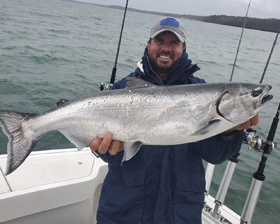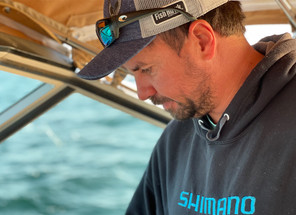Posted by Chris Larsen on 29th Jan 2021
Garmin Panoptix for Trout & Salmon Trolling
Captain Casey Prisco has been fishing Lake Ontario since he was a child. “I started when I was four. My dad used to bring me up. Me, my dad, and my grandfather. I was hooked forever.” Now he operates Dirty Goose Sportfishing on Lake Ontario and is a big believer in Garmin Panoptix for Great Lakes trolling. “Garmin Panoptix is going to be a transom mount for our application in the Great Lakes. You can see all three downriggers. It’s going to show you positive, active fish and negative fish. You can see a fish come in and look at a downrigger and shoot down and look at another downrigger. It’s a gamechanger. To tell you it’s made me a better fisherman... absolutely.”
 Prisco says Panoptix allows him to see what standard sonar can’t. Sometimes a rod that isn’t catching fish is helping to produce bites on other rods. He can see this happen while watching his Panoptix screen. “You’re best rig may never take a bite but it brings a fish into your spread and they shoot down and hit another rig. In the past, you may say “that rod isn’t going let’s switch it out.” But when you switch it out the bite just died. You took your best rod, even though it didn’t take a bite, out of the water. Time and time again you see it. Size of lures, direction, speed, you see it all. And it’s live, happening right in front of you. You have all the tools right in front of you to make it happen. It’s just being able to take what you’re seeing, gather the right information from it, and execute what they want.”
Prisco says Panoptix allows him to see what standard sonar can’t. Sometimes a rod that isn’t catching fish is helping to produce bites on other rods. He can see this happen while watching his Panoptix screen. “You’re best rig may never take a bite but it brings a fish into your spread and they shoot down and hit another rig. In the past, you may say “that rod isn’t going let’s switch it out.” But when you switch it out the bite just died. You took your best rod, even though it didn’t take a bite, out of the water. Time and time again you see it. Size of lures, direction, speed, you see it all. And it’s live, happening right in front of you. You have all the tools right in front of you to make it happen. It’s just being able to take what you’re seeing, gather the right information from it, and execute what they want.”
Garmin Panoptix is still viewed as new technology to many anglers. Prisco understands the hesitation but believes Panoptix has made him a better, more successful angler. “I think everyone is hesitant at first on new things. No one likes change. A lot of us are set in our ways. I’m set in my ways. I have thousands and thousands of dollars worth of fishing equipment and every year I use the same 50 attractors and 50 spoons. To evolve, adapt, and become better you better not be set in your ways.”
Having multiple screens in the boat allows the information to be shared with Captain Prisco, his mate, and his charter clients. “I have two 7610 units with a 10” screen set up in the front of my boat. In the back, I have an 8” screen. They’re all networked. I like my clients to be able to see it as it is going on and see exactly what is happening. They can watch the one in the back. If they’re sitting by me they can see it. My mate can watch it. I can compare traditional sonar because I do have a regular sonar in the boat. Side-by-side you can see the difference. It’s night and day. It’s amazing. You can see what is really happening with Panoptix compared to what your other transducer is showing you. You learn a lot. Sometimes you think a fish is following you. That fish swam 50 feet off to the side. He’s still in your cone and you’re still marking him because it’s straight-up-and-down sonar, traditional.”
 Mounting is simple. “It’s a transom mount transducer. It’s got a nice stainless bracket. It’s about 4”x6”. You run the cable up to your unit… You can link units together. That’s it. Power up the unit and go. There’s not a ton of adjustment like I’ve seen with past units.”
Mounting is simple. “It’s a transom mount transducer. It’s got a nice stainless bracket. It’s about 4”x6”. You run the cable up to your unit… You can link units together. That’s it. Power up the unit and go. There’s not a ton of adjustment like I’ve seen with past units.”
Prisco says the most important factor in using a Panoptix effectively is to get the gain settings set so your downrigger cables aren’t displaying blowback. “There’s an adjustment in your Panoptix where you can change your transmission angle. You want to change your transmission angle so you’re marking your downriggers clear. That’s the biggest thing. You can move the gain up and down or put it on auto. They have a lot of great settings to make it easy. Once you have that set, the rest of it is just watching. It’s simple.”
Captain Casey Prisco is a recent guest on the Great Lakes Fishing Podcast. To hear more from the conversation, click the player below or go to the podcast page to listen to all episodes from the Great Lakes Fishing Podcast.

